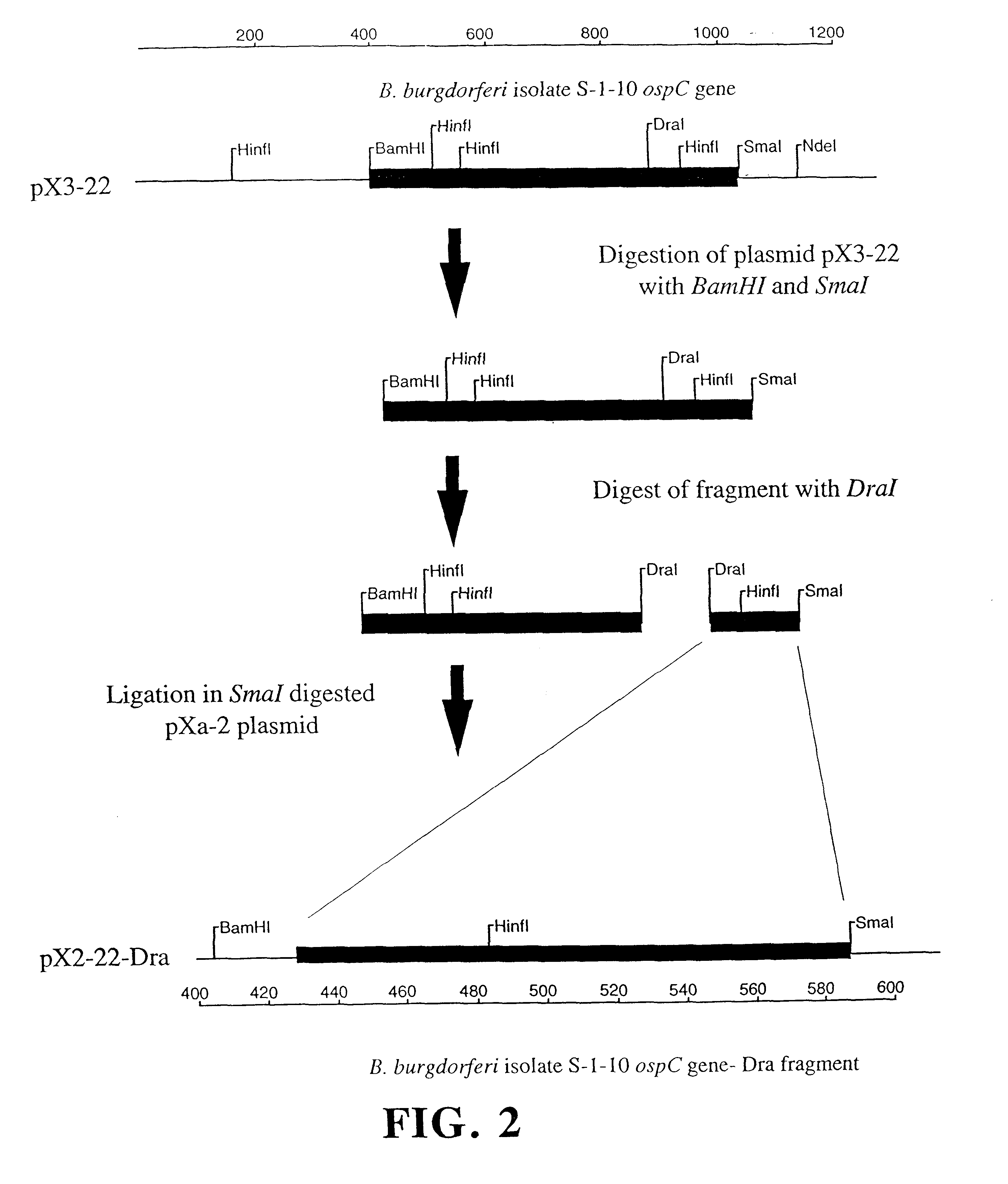Compositions and methods using the borreliacidal epitope(s) of borrelia burgdorferi outer surface protein C (OspC) for the diagnosis and prevention of lyme disease
a technology of outer surface protein and borrelia burgdorferi, which is applied in the direction of peptides, enzymology, drug compositions, etc., can solve the problems of significant morbidity worldwide, increased risk of neurological or joint complications, and mixed results
- Summary
- Abstract
- Description
- Claims
- Application Information
AI Technical Summary
Benefits of technology
Problems solved by technology
Method used
Image
Examples
example 1
This example demonstrates the ability of B.b. OspC to induce high levels of borreliacidal antibodies when administered shortly after B.b. infection.
Materials and Methods
Organisms. B.b. sensu stricto isolate 297 (deposited with American Type Culture Collection, 10801 University Blvd., Manassas, Va. 20110 under ATTC Accession Number 53899) was isolated from human spinal fluid. B.b. sensu stricto isolate 50772 (deposited with the American Type Culture Collection on Jul. 30, 1999 according to the terms of the Budapest Treaty), originally isolated from an I. scapularis tick, was obtained from John F. Anderson (Connecticut Agricultural Experiment Station, New Haven, Conn.). The spirochete lacks the OspA / B operon and hence does not express OspA or OspB (25). The original suspensions of spirochetes were serially 10-fold diluted in Barbour-Stoenner-Kelly (BSK) medium capable of supporting growth from a single organism (46). The resultant population of spirochetes was then passaged 10 times i...
example 2
This example demonstrates that the borreliacidal epitopes of OspC are located within the Dra fragment region.
Step a: Isolation of Plasmids, Cloning, and Amplification of the ospC Gene. Plasmid-enriched DNA was isolated from B.b. sensu stricto isolate S-1-10 using standard techniques (13). The DNA was then used as a template for the amplification of the ospC gene by the GeneAmp protocol (Perkin Elmer Cetus, Norwalk, Conn.) using the polymerase chain reaction (34). Primers were used at a final concentration of 1.0 .mu.m with a MgCl.sub.2 concentration of 1.5 mM. Thermal cycling parameters were 95.degree. C. for 5 min followed by 35 cycles of the following: 1) 95.degree. C. for 30 sec, 2) 50.degree. C. for 30 sec, 3) 72.degree. C. for 90 sec. The final extension was done at 72.degree. C. for 7 min to fully extend any truncated DNA strands. The amino-terminal primer C1 5'-CGTGGATCCATGAAAAAGAATACATTAAGTGCGATA-3' and the carboxy-terminal primer C2 5'-AATTCCCGGGTTAAGGTTTTTTTGGACTTTCTGC-3' ...
example 3
This example demonstrates that anti-OspC antibodies which are specific to the Dra fragment region of OspC can be detected by ELISA.
Dra Fragment ELISA. Purified OspC Dra fragment was diluted to 750 ng / ml in coating buffer (0.015M Na.sub.2 CO.sub.3, 0.035M NaHCO.sub.3, pH 9.6) and added to flat-bottom N-oxysuccinimide surface amino binding microtiter wells. The ELISA plates were incubated at 35.degree. C. for 4 hours followed by an overnight incubation at 4.degree. C. After incubation, plates were washed 3 times with PBS containing 0.05% TWEEN 20 brand detergent, sealed, and stored at 4.degree. C. Before using, plates were blocked with PBS-0.05% TWEEN 20 brand detergent containing 1% bovine serum albumin for 30 min at ambient temperature. Plates were washed twice with PBS-0.05 % TWEEN 20 brand detergent and 100 .mu.l of serial 2-fold dilutions of serum in PBS was added to the individual microtiter wells. Plates were incubated for 1 hour at 22.degree. C. followed by 3 washes with PBS-0...
PUM
| Property | Measurement | Unit |
|---|---|---|
| pH | aaaaa | aaaaa |
| pH | aaaaa | aaaaa |
| flow rate | aaaaa | aaaaa |
Abstract
Description
Claims
Application Information
 Login to View More
Login to View More - R&D
- Intellectual Property
- Life Sciences
- Materials
- Tech Scout
- Unparalleled Data Quality
- Higher Quality Content
- 60% Fewer Hallucinations
Browse by: Latest US Patents, China's latest patents, Technical Efficacy Thesaurus, Application Domain, Technology Topic, Popular Technical Reports.
© 2025 PatSnap. All rights reserved.Legal|Privacy policy|Modern Slavery Act Transparency Statement|Sitemap|About US| Contact US: help@patsnap.com



